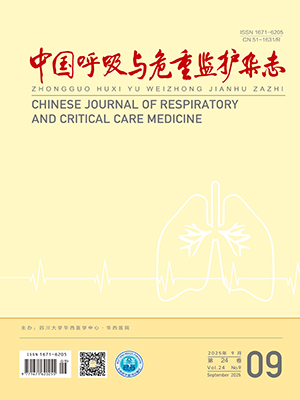| 1. |
Murgu SD, Egressy K, Laxmanan B, et al. Central airway obstruction: benign strictures, tracheobronchomalacia, and malignancy-related obstruction. Chest, 2016, 150(2): 426-441.
|
| 2. |
Kızılgöz D, Aktaş Z, Yılmaz A, et al. Comparison of two new techniques for the management of malignant central airway obstruction: argon plasma coagulation with mechanical tumor resection versus cryorecanalization. Surg Endosc, 2018, 32(4): 1879-1884.
|
| 3. |
Oki M, Saka H, Hori K. Airway stenting in patients requiring intubation due to malignant airway stenosis: a 10-year experience. J Thorac Dis, 2017, 9(9): 3154-3160.
|
| 4. |
Cheng WC, Shen MF, Wu BR, et al. The prognostic predictors of patients with airway involvement due to advanced esophageal cancer after metallic airway stenting using flexible bronchoscopy. J Thorac Dis, 2019, 11(9): 3929-3940.
|
| 5. |
Ong P, Grosu HB, Debiane L, et al. Long-term quality-adjusted survival following therapeutic bronchoscopy for malignant central airway obstruction. Thorax, 2019, 74(2): 141-156.
|
| 6. |
Stratakos G, Gerovasili V, Dimitropoulos C, et al. Survival and quality of life benefit after endoscopic management of malignant central airway obstruction. J Cancer, 2016, 7(7): 794-802.
|
| 7. |
Burningham AR, Wax MK, Andersen PE, et al. Metallic tracheal stents: complications associated with long-term use in the upper airway. Ann Otol Rhinol Laryngol, 2002, 111(4): 285-290.
|
| 8. |
Kock ID, Mirhosseini M, Lau F, et al. Conversion of karnofsky performance status (KPS) and Eastern Cooperative Oncology Group Performance Status (ECOG) to palliative performance scale (PPS), and the interchangeability of PPS and KPS in prognostic tools. J Palliative Care, 2013, 29(3): 163-169.
|
| 9. |
Guan WJ, Li SY, Zhong NS. Effects of para-toluenesulfonamide intratumoral injection on pulmonary adenoid cystic carcinoma complicating with severe central airway obstruction: a 5-year follow-up study. J Thorac Dis, 2018, 10(4): 2448-2455.
|
| 10. |
Xu J, Ong HX, Traini D, et al. The utility of 3D-printed airway stents to improve treatment strategies for central airway obstructions. Drug Dev Ind Pharm, 2019, 45(1): 1-10.
|
| 11. |
周正, 王林梅, 韩校鹏, 等. 纤维支气管镜直视下有创机械通气中置入金属支架治疗恶性肿瘤致中心气道狭窄的临床应用. 中国内镜杂志, 2020, 26(4): 20-24.
|
| 12. |
Verma A, Phua CK, Wu QM, et al. Our clinical experience of self-expanding metal stent for malignant central airway obstruction. J Clin Med Res, 2017, 9(1): 58-63.
|
| 13. |
宫蓓蕾, 沈圆兵, 陈余清, 等. 硬质气管镜联合电子气管镜在中心气道重度狭窄治疗中的价值. 西安交通大学学报(医学版), 2020, 41(2): 268-274.
|
| 14. |
Verma A, Goh SK, Tai DYH, et al. Outcome differences between recanalized malignant central airway obstruction from endoluminal disease versus extrinsic compression. Lasers Med Sci, 2019, 34(5): 955-962.
|
| 15. |
李冬妹, 王洪武, 张楠, 等. 恶性中心气道狭窄的狭窄类型与气管镜介入治疗疗效及预后的关系. 国际呼吸杂志, 2019, 39(10): 772-775.
|
| 16. |
Axelrad J, Kriplani A, Ozbek U, et al. Chemotherapy tolerance and oncologic outcomes in patients with colorectal cancer with and without inflammatory bowel disease. Clin Colorectal Cancer, 2017, 16(3): 205-210.
|
| 17. |
Gao S, Wu M, Chen Y, et al. Lactic dehydrogenase to albumin ratio in prediction of unresectable pancreatic cancer with intervention chemotherapy. Future Oncol, 2018, 14(14): 1377-1386.
|
| 18. |
Mack N, Mazzio EA, Bauer D, et al. Stable shRNA silencing of lactate dehydrogenase a (LDHA) in human mda-mb-231 breast cancer cells fails to alter lactic acid production, glycolytic activity, ATP or survival. Anticancer Res, 2017, 37(3): 1205-1212.
|
| 19. |
Hong SM, Lee YK, Park I, et al. Lactic acidosis caused by repressed lactate dehydrogenase subunit B expression down-regulates mitochondrial oxidative phosphorylation via the pyruvate dehydrogenase (PDH)-PDH kinase axis. J Biol Chem, 2019, 294(19): 7810-7820.
|
| 20. |
Rice TW, Gress DM, Patil DT, et al. Cancer of the esophagus and esophagogastric junction-Major changes in the American Joint Committee on Cancer eighth edition cancer staging manual. CA Cancer J Clin, 2017, 67(4): 304-317.
|
| 21. |
梁俊超, 李国平. 氩气刀联合高频电刀或冷冻治疗恶性气道狭窄的疗效. 中国老年学杂志, 2019, 39(16): 3980-3983.
|
| 22. |
梁钰安, 梁自安, 李奋强, 等. 125I 放射性粒子支架植入联合 TACE 治疗肝门部胆管癌的临床疗效对比分析. 介入放射学杂志, 2016, 25(9): 821-825.
|




